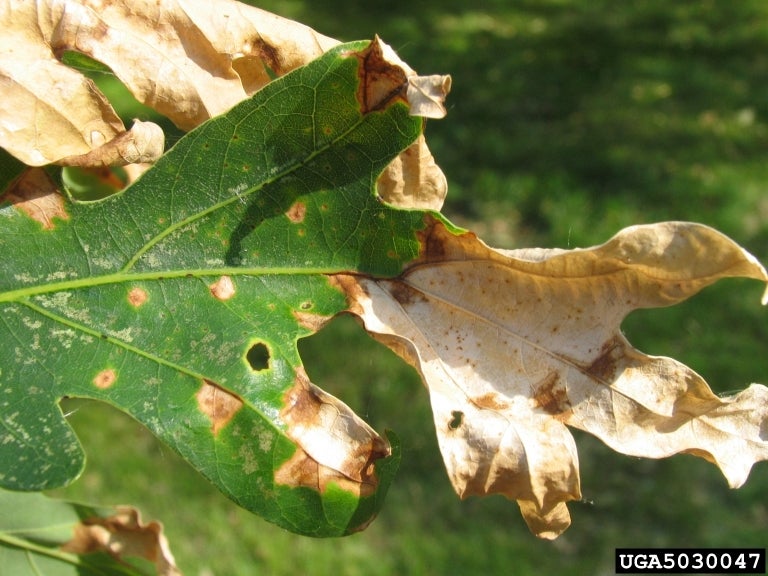Anthracnose is a fungal disease that affects many species of deciduous trees and shrubs. Shade trees such as ash, maple, oak, and sycamore are commonly damaged. Details of how anthracnose affects each tree species are below.
Symptoms and Signs
- Spotted, blotched, or distorted leaves
- A scorched appearance from a distance
- Partial or complete defoliation (loss of leaves) in early spring
- Shoot blight, twig cankers, and dieback when infections are severe
Recommendations
- Reduce stress through good tree care practices (mulching, watering, avoiding wounds, etc.).
- Prune to improve air flow through the canopy.
- Rake and destroy fallen leaves to reduce future infections.

Preventive Treatment
Fungicides can be used as a preventive but must be applied before symptoms appear. Full coverage of buds and twigs is necessary. Look for fungicides containing propiconazole, thiophanate methyl, copper, mancozeb, or chlorothalonil listed as the active ingredient. Always read and carefully follow fungicide label instructions.
Treatment for anthracnose is generally not necessary but may be warranted on trees that have lost their leaves several years in a row.
Title
Ash Anthracnose
Joseph O'Brien, USDA Forest Service,
Bugwood.org
Ash anthracnose is caused by the fungal pathogen Gnomoniella fraxini. In early spring, infections first appear as water-soaked areas (lesions) on expanding leaves and shoots. As growth continues, lesions rapidly enlarge and turn brown. Leaves often become curled or distorted as they grow around these dead areas.
Severity of ash anthracnose is increased by prolonged wet spring weather. Under these conditions, infections of new shoots can be so severe that the entire first flush of shoots is killed. This damage is very similar in appearance and timing to frost damage. When leaves are heavily infected, trees may experience rapid leaf drop and nearly complete defoliation early in the growing season.
Title
Oak Anthracnose
Joseph O'Brien, USDA Forest Service, Bugwood.org
Anthracnose of oaks is typically caused by the pathogens Apiognomonia quercina and A. errabunda. Severity of oak anthracnose symptoms depend on weather conditions, timing, growth stage and species of oak. Severe infections often follow prolonged cool, wet conditions in early spring.
While many oak species may be infected with anthracnose, white oak (Quercus alba) is highly susceptible. Symptoms of anthracnose on white oak include leaf and shoot blight, distorted leaves with large dead areas, and brown spots on regularly shaped mature leaves. Infection often follows major leaf veins. Anthracnose-infected shoots may develop twig cankers and experience some dieback. Trees with severe anthracnose infection exhibit a scorched or blighted appearance.
Title
Maple Anthracnose
lesions and spots along major leaf veins.
MDC staff
Maple anthracnose is caused by several species of fungi that infect leaves and young shoots. Infection of leaf tissue often results in brown lesions and spots associated with major leaf veins. Young, expanding leaves infected early in the spring may shrivel and turn brown entirely.
While much of the anthracnose on maple leaves results from weather conditions in spring, young shoots can become infected throughout the growing season. New, succulent shoots, such as those resulting from insect defoliation or improper fertilization, are particularly susceptible and may be killed by anthracnose infection.
Title
Sycamore Anthracnose
William Jacobi, Colorado State University,
Bugwood.org
Anthracnose of sycamore is among the more serious of these diseases. The pathogen Apiognomonia veneta causes leaf and shoot blight, twig cankers, dieback, and even branch deformity over time. Infected leaves display purple-brown lesions along major veins or may be stunted due to cankers in twigs.
Repeated loss of buds and twigs due to cankers can cause dieback and deformity of branches. Anthracnose infection of terminal buds contributes to American sycamore’s characteristic right-angle branching pattern. Branch dieback may cause loss of tree vigor, decline in health, and increased susceptibility to insect attack.
Title
Dogwood Anthracnose — Be on the Lookout!
anthracnose.
Mary Ann Hansen, Virginia Polytechnic Institute
and State University, Bugwood.org
Dogwood anthracnose, caused by the nonnative fungus Discula destructiva, is a devastating disease of flowering dogwood. Since the late 1970s, the disease has caused significant dogwood mortality in the eastern United States. Dogwood anthracnose is easily transported through the nursery trade and has been found in the St. Louis area. Unlike the native spot anthracnose commonly seen on dogwoods, infection by dogwood anthracnose causes large lesions on leaves, twig cankers, and branch dieback.
For suspected dogwood anthracnose infections, contact your local MDC forester or report findings to Forest.Health@mdc.mo.gov.


























